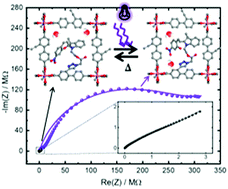当前位置:
X-MOL 学术
›
Chem. Sci.
›
论文详情
Our official English website, www.x-mol.net, welcomes your
feedback! (Note: you will need to create a separate account there.)
Proton-conduction photomodulation in spiropyran-functionalized MOFs with large on–off ratio
Chemical Science ( IF 7.6 ) Pub Date : 2019/12/18 , DOI: 10.1039/c9sc04926f Anemar Bruno Kanj 1, 2, 3, 4 , Abhinav Chandresh 1, 2, 3, 4 , Aaron Gerwien 4, 5, 6, 7 , Sylvain Grosjean 1, 3, 4, 8 , Stefan Bräse 1, 1, 3, 4, 8 , Yuemin Wang 1, 2, 3, 4 , Henry Dube 4, 5, 6, 7 , Lars Heinke 1, 2, 3, 4
Chemical Science ( IF 7.6 ) Pub Date : 2019/12/18 , DOI: 10.1039/c9sc04926f Anemar Bruno Kanj 1, 2, 3, 4 , Abhinav Chandresh 1, 2, 3, 4 , Aaron Gerwien 4, 5, 6, 7 , Sylvain Grosjean 1, 3, 4, 8 , Stefan Bräse 1, 1, 3, 4, 8 , Yuemin Wang 1, 2, 3, 4 , Henry Dube 4, 5, 6, 7 , Lars Heinke 1, 2, 3, 4
Affiliation

|
Proton conduction in nanopores is important for applications in fuel cells, chemical sensors and information processing devices inspired by nature. Here, we present a nanoporous material, a metal–organic framework (MOF) thin film, allowing photomodulation of the aqueous and alcoholic proton conduction of the guests by almost two orders of magnitude. The MOF film possesses spiropyran groups which undergo reversible UV-light induced isomerization to the merocyanine form, a highly polar, zwitterionic molecule, where the strong binding of the guests to the merocyanine isomer efficiently suppresses the proton conduction. Such materials with photomodulated ionic conduction contribute to the development of advanced, remote-controllable chemical sensors and to switchable devices interfacing with biological systems.
中文翻译:

螺吡喃官能化MOF中质子传导的光调制,具有较大的开-关比
纳米孔中的质子传导对于受自然启发的燃料电池,化学传感器和信息处理设备中的应用很重要。在这里,我们介绍了一种纳米多孔材料,一种金属-有机骨架(MOF)薄膜,可以对客体的水和醇质子传导进行光调制,几乎可以达到两个数量级。MOF膜具有螺吡喃基团,螺吡喃基团经历可逆的紫外光诱导的异构化为花菁形式(一种高度极性的两性离子分子),其中客体与花菁异构体的牢固结合有效地抑制了质子传导。具有光调制离子传导性的此类材料有助于开发先进的,可远程控制的化学传感器,并有助于与生物系统接口的可切换设备。
更新日期:2020-02-13
中文翻译:

螺吡喃官能化MOF中质子传导的光调制,具有较大的开-关比
纳米孔中的质子传导对于受自然启发的燃料电池,化学传感器和信息处理设备中的应用很重要。在这里,我们介绍了一种纳米多孔材料,一种金属-有机骨架(MOF)薄膜,可以对客体的水和醇质子传导进行光调制,几乎可以达到两个数量级。MOF膜具有螺吡喃基团,螺吡喃基团经历可逆的紫外光诱导的异构化为花菁形式(一种高度极性的两性离子分子),其中客体与花菁异构体的牢固结合有效地抑制了质子传导。具有光调制离子传导性的此类材料有助于开发先进的,可远程控制的化学传感器,并有助于与生物系统接口的可切换设备。











































 京公网安备 11010802027423号
京公网安备 11010802027423号